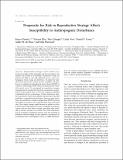Files in this item
Propensity for risk in reproductive strategy affects susceptibility to anthropogenic disturbance
Item metadata
| dc.contributor.author | Pirotta, Enrico | |
| dc.contributor.author | Hin, Vincent | |
| dc.contributor.author | Mangel, Marc | |
| dc.contributor.author | New, Leslie | |
| dc.contributor.author | Costa, Daniel P. | |
| dc.contributor.author | de Roos, André M. | |
| dc.contributor.author | Harwood, John | |
| dc.date.accessioned | 2021-08-30T23:36:20Z | |
| dc.date.available | 2021-08-30T23:36:20Z | |
| dc.date.issued | 2020-10 | |
| dc.identifier | 270346057 | |
| dc.identifier | 4a73c790-5145-4b88-8e36-a79057d6e991 | |
| dc.identifier | 85090962222 | |
| dc.identifier | 000572415900001 | |
| dc.identifier.citation | Pirotta , E , Hin , V , Mangel , M , New , L , Costa , D P , de Roos , A M & Harwood , J 2020 , ' Propensity for risk in reproductive strategy affects susceptibility to anthropogenic disturbance ' , American Naturalist , vol. 196 , no. 4 , pp. E71–E87 . https://doi.org/10.1086/710150 | en |
| dc.identifier.issn | 0003-0147 | |
| dc.identifier.uri | https://hdl.handle.net/10023/23869 | |
| dc.description | Funding: E.P., V.H., J.H., L.N., and D.P.C. were supported by Office of Naval Research (ONR) grant N00014-16-1-2858 (“PCoD+: Developing Widely-Applicable Models of the Population Consequences of Disturbance”). D.P.C. was supported by the Exploration and Production Sound and Marine Life Joint Industry Project of the International Association of Oil and Gas Producers. A.M.d.R. and V.H. were funded by European Research Council Grant no. 322814 awarded to A.M.d.R. M.M. was supported by ONR grant N00014-19-2494. | en |
| dc.description.abstract | Animals initiate, interrupt, or invest resources in reproduction in light of their physiology and the environment. The energetic risks entailed in an individual’s reproductive strategy can influence the ability to cope with additional stressors, such as anthropogenic climate change and disturbance. To explore the trade-offs between internal state, external resource availability, and reproduction, we applied state-dependent life-history theory (SDLHT) to a dynamic energy budget (DEB) model for long-finned pilot whales (Globicephala melas). We investigated the reproductive strategies emerging from the interplay between fitness maximization and propensity to take energetic risks, as well as the resulting susceptibility of individual vital rates to disturbance. Without disturbance, facultative reproductive behavior from SDLHT and fixed rules in the DEB model led to comparable individual fitness. However, under disturbance, the reproductive strategies emerging from SDLHT increased vulnerability to energetic risks, resulting in lower fitness than fixed rules. These fragile strategies might therefore be unlikely to evolve in the first place. Heterogeneous resource availability favored more cautious (and thus more robust) strategies, particularly when knowledge of resource variation was accurate. Our results demonstrate that the assumptions regarding the dynamic trade-offs underlying an individual’s decision-making can have important consequences for predicting the effects of anthropogenic stressors on wildlife populations. | |
| dc.format.extent | 13570603 | |
| dc.language.iso | eng | |
| dc.relation.ispartof | American Naturalist | en |
| dc.subject | Dynamic energy budget | en |
| dc.subject | Life-history trade-offs | en |
| dc.subject | Marine mammals | en |
| dc.subject | Population consequences of disturbance | en |
| dc.subject | Resource availability | en |
| dc.subject | Stochastic dynamic programming | en |
| dc.subject | QH301 Biology | en |
| dc.subject | Ecology, Evolution, Behavior and Systematics | en |
| dc.subject | 3rd-DAS | en |
| dc.subject | SDG 13 - Climate Action | en |
| dc.subject | SDG 14 - Life Below Water | en |
| dc.subject.lcc | QH301 | en |
| dc.title | Propensity for risk in reproductive strategy affects susceptibility to anthropogenic disturbance | en |
| dc.type | Journal article | en |
| dc.contributor.institution | University of St Andrews. School of Biology | en |
| dc.identifier.doi | https://doi.org/10.1086/710150 | |
| dc.description.status | Peer reviewed | en |
| dc.date.embargoedUntil | 2021-08-31 |
This item appears in the following Collection(s)
Items in the St Andrews Research Repository are protected by copyright, with all rights reserved, unless otherwise indicated.

